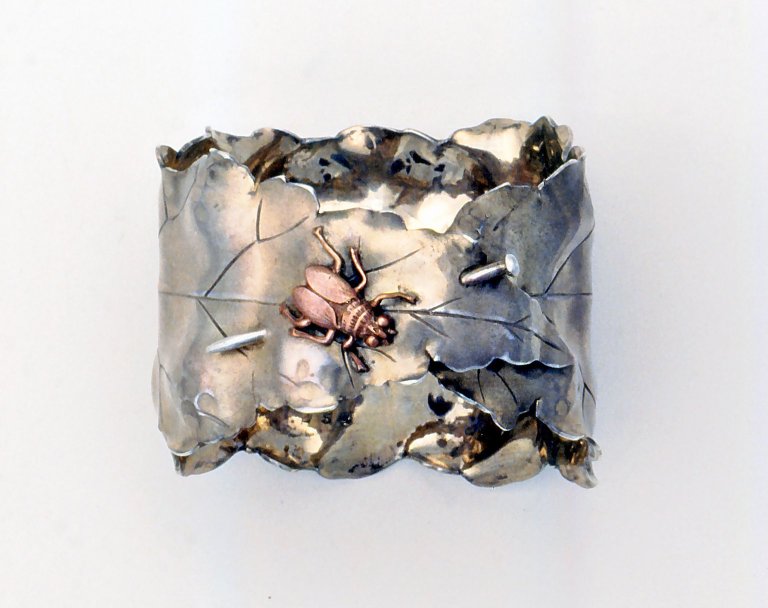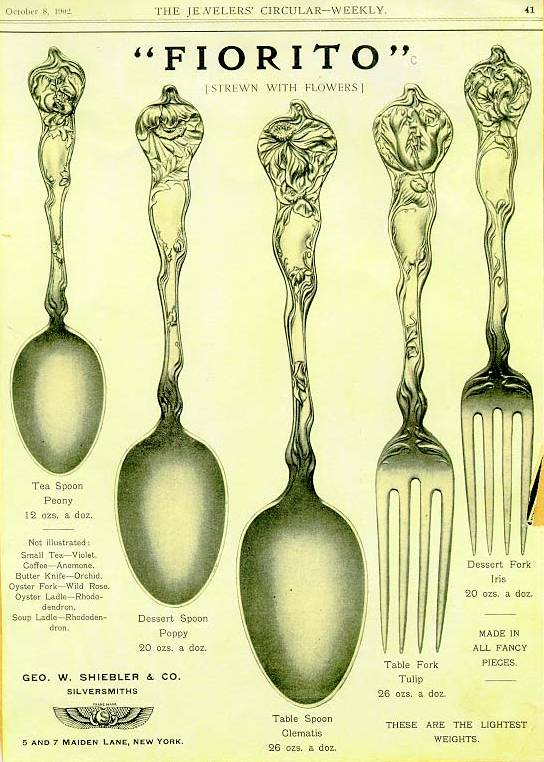A Pair of 'Japoniste' Parcel-Gilt Silver and Mixed-Metal Silver Bowls
Mark of George W. Shiebler, New York, circa 1883
The shaped oval bowls formed as folded maple leaves and applied with a spider on the stem and a copper fly on the leaf, each stamped on the underside with the firm's mark and STERLING 279, one stamped with the retailer's mark J.E. CALDWELL & Co., and the other stamped with the retailer's mark WM. WILSON & SON
Each bowl: 2 in (5.1 cm) high, 7 in (17.8 cm) wide, 3 ½ in (8.9 cm) deep
cf. Janet Zapata and D. Albert Soeffing, 'Artistic Wares of George W. Shiebler, Silversmith', The Magazine Antiques, July 1995, p.100
Each bowl: 2 in (5.1 cm) high, 7 in (17.8 cm) wide, 3 ½ in (8.9 cm) deep
cf. Janet Zapata and D. Albert Soeffing, 'Artistic Wares of George W. Shiebler, Silversmith', The Magazine Antiques, July 1995, p.100
George Shiebler founded his New York firm in 1876 with the acquisition of the Coles and Reynolds concern, makers of silver spoons. Over the course of the next few years, Shiebler acquired the factory of Morgan Morgans Jr. (successor to Albert Coles), the firm of John Polhamus and the flatware pattern dies of Albert Coles, Hebbard & Polhamus, A. & W. Wood, Theodore Evans & Co., and a number of those of Henry Hebbard.
Within a few years of founding, Shiebler consolidated the manufacturing equipment and moved his operation to Brooklyn, New York. He continued producing flatware patterns of his predecessor's design as well as patenting and manufacturing designs of his own, most notably his medallion based 'Etruscan'.
The firm also produced high quality sterling and mixed metal ware, novelties, souvenir spoons and jewellery. They became known for their imaginative and often fanciful pieces with subjects such as leaf work and sea motifs based upon the Art Nouveau and Japonisme. In the early 1880s, after introducing hollow-ware made out of naturalistic silver leaves, the company created leaf-form pieces applied with spiders, flies and beetles, similar to the pieces by Tiffany and Gorham's Japanese-inspired silverware from the late 1870s. George W. Shiebler & Co was dissolved in 1910.
A silver and copper napkin ring with a similar design and decoration is held in the Brooklyn Museum. Other works by Shiebler can be found in the Indianapolis Museum of Art, the Philadelphia Museum of Art and the Dallas Museum of Art.
Within a few years of founding, Shiebler consolidated the manufacturing equipment and moved his operation to Brooklyn, New York. He continued producing flatware patterns of his predecessor's design as well as patenting and manufacturing designs of his own, most notably his medallion based 'Etruscan'.
The firm also produced high quality sterling and mixed metal ware, novelties, souvenir spoons and jewellery. They became known for their imaginative and often fanciful pieces with subjects such as leaf work and sea motifs based upon the Art Nouveau and Japonisme. In the early 1880s, after introducing hollow-ware made out of naturalistic silver leaves, the company created leaf-form pieces applied with spiders, flies and beetles, similar to the pieces by Tiffany and Gorham's Japanese-inspired silverware from the late 1870s. George W. Shiebler & Co was dissolved in 1910.
A silver and copper napkin ring with a similar design and decoration is held in the Brooklyn Museum. Other works by Shiebler can be found in the Indianapolis Museum of Art, the Philadelphia Museum of Art and the Dallas Museum of Art.

















